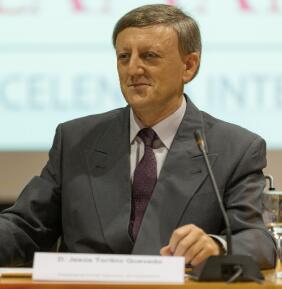
The 6th Global Conference on Polymer and Composite Materials (PCM 2019)


Biography: Professor Jesús Toribio graduated in Civil Engineering in 1982 and then in Mathematics in 1986. In 1987 he was awarded his PhD in the Polytechnic University of Madrid (UPM) and turned into Associate Professor in that Institution. In 1992 he became Full Professor and Head of the Materials Science Department of the University of La Coruña (at the age of 32, thus being the youngest Full Professor in the area of Materials Science in Spain). In 2000 he moved to the University of Salamanca (USAL) where is currently Full Professor of Materials Science and Head of the Fracture and Structural Integrity Research Group (FSIRG) of that Institution.
His research work is mainly concerned with fatigue and fracture mechanics, environmentally assisted cracking, stress corrosion cracking and hydrogen embrittlement/degradation/damage of metals and alloys (mainly cold drawn pearlitic steel wires for civil engineering and austenitic stainless steels for nuclear engineering and energy applications), covering theoretical, computational and experimental aspects. He actively participates in International Conferences, very often being member of the International Advisory Committee, organising Special Sessions/Symposia, being Session Chairman or delivering Plenary/Keynote/Invited Lectures. Professor Dr. Jesús Toribio has published more than 500 scientific papers, most of them in international books and journals.
He is the Chairman of the Technical Committee 10 (TC10): Environmentally Assisted Cracking of the European Structural Integrity Society (ESIS) and has been Director (2013-2017) of the International Congress of Fracture-The World Academy of Structural Integrity (ICF-WASI), being responsible of launching the Ibero-American Academy of Structural Integrity (IA2SI). Prof. Toribio has been awarded a variety of scientific research prizes and awards including: (i) UPM Young Scientist Award of the Polytechnic University of Madrid; (ii) METROTEC Award for the best Technological Research Project; (iii) Honour Medal of the Spanish Group of Fracture (GEF/SEIE) in recognition of his research achievements in the field of fracture mechanics; (iv) Fellow of the Wessex Institute of Technology (WIT) in recognition of leadership and outstanding work in engineering sciences; (v) Top Reviewer 2011 in recognition of an outstanding contribution to the quality of the Elsevier International Journal Engineering Fracture Mechanics; (vi) Fellow of the European Structural Society (ESIS Fellow) for his outstanding contributions to the art, science, teaching or practice of fracture mechanics and his service to the society; (vii) Honorary Member of the Italian Group of Fracture (IGF) in acknowledgement and appreciation of his outstanding achievements in the research field of fracture mechanics; (viii) Best Paper and Presentation Award in the International Conference on Energy Materials and Applications (ICEMA 2017) held in 2017 in Hiroshima, Japan, with a paper entitled: Numerical Simulation of Hydrogen Diffusion in the Pressure Vessel Wall of a WWER-440 Reactor; (ix) María de Maeztu Scientific Award of the University of Salamanca (800th anniversary during 2018) in recognition of academic trajectory and excellence in scientific and technological research.
Speech Title: Cold drawn pearlitic steels as hierarchically structured nanocomposite materials for civil engineering construction: A tribute to Fray Luis de León, Miguel de Cervantes and Johann Sebastian Bach
Abstract: Cold drawn pearlitic steels posses an inherent hierarchical microstructure consisting of pearlitic colonies (first microstructural level) and pearlite (ferrite/Fe and cementite/Fe3C) lamellae (second microstructural level), so that they can be considered as nano-composites from the materials science & engineering point of view. Such a microstructure evolves during the manufacturing process by cold drawing towards a preferential orientation aligned in the drawing (wire axis) direction, so that these materials acquire microstructural anisotropy that influences their posterior fracture and structural integrity behaviour at different scales, so that a multi-scale approach to the problem can be established, formulating the innovative concepts of macro-, micro- and nano-structural integrity. The paper establishes an analogy with the literature of Spanish writers Fray Luis de León and Miguel de Cervantes (through the alternate distribution of ferrite/cementite lamellae) and the composer Johann Sebastian Bach (through the hierarchical structure of his music).